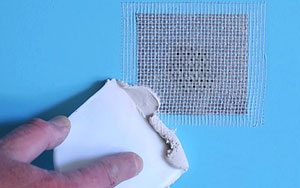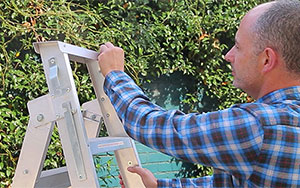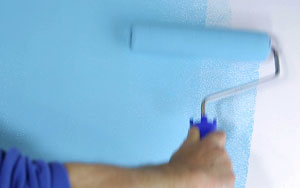Hammering Hints
When nailing dense timbers like Jarrah and Red Gum or to prevent splitting near ends, drill a hole the same size or slightly smaller than the nail to act as a guide.
Rivet Removal
Blind rivets are easily removed to allow repair or replacement work by using a drill bit of the same size as the original hole.
Squeaky Floorboards
Use talcum powder in the cracks between floorboards to stop squeaks. Fix loose floorboards that squeak with a hammer and use a nail punch to drive down nails. If this doesn’t work, drill holes next to the nails and fix boards with counter-sunk headscrews.
Installing Timber Panelling
Stand the boards against the wall keeping them out of any direct sunlight to acclimatise them to the surrounding conditions. Then, a protective coating of clear water repellent or polyurethane should be applied.
Unblocking Drains
Place rubber plunger tightly over the drain and fill the sink with water until plunger is covered. Pump plunger up and down. If the blockage remains look for an obstruction in the S-bend. Put a bucket under the sink and loosen the slip nut or undo the drainage plug at the base of the S-bend.
Building a Stud Wall
Measure the area and include space for a door if needed. Space the studs (the vertical timbers) so that the door will fit properly. Stud walls should be located above the floor joist. The stud wall should then be assembled on the floor and lifted into position.
Rising Damp
To fix rising damp check that paths around the home are set below the level of the damp-proof course. Also, check every vent to make sure that nothing is obstructing the airflow, ensure drainpipes run into proper drains and paint outside walls with good acrylic paint or lime wash so that they can breathe.
Tool Care
Tools with wooden handles should be rubbed periodically with a mixture of two parts mineral turpentine to one part linseed oil to prevent drying out and splinters. If implements are rusty, scrub with steel wool and apply oil.
Simple Power Sanding
Keep the sander moving along the surface to avoid it’s edge digging in and heat building up or clogging. Sand lengthways along surface and don’t press too hard, let the sander do the work. Use low speed for fibreglass and non-ferrous materials and always wear eye protection.
Choosing Bolts and Nuts
Use Hex Head bolts when fixing metal to timber, and where practical put a metal piece under the head and washer under the nut. When fixing a Cup Head bolt put a washer between wood and nut. And use a metal piece under the head of a Coach Screw when fixing metal to timber.
Drilling Screws
When fixing to timber the embedment depth should be 25mm into the timber being fastened and 20mm for plasterboard and chipboard. When fixing to metal the embedment depth should be the thickness of the material being fastened to, plus drilling capacity and three threads protruding beyond the metal being fastened.
Installing Insulation
Wear a dust mask, goggles, gloves, overalls and long sleeves to avoid health risks. Transfer the batts into the roof before opening them so they remain easy to store and transport. Always start at the most distant point from the access hatch and work forward, leaving odd shaped areas until last.
Squeaking Door
Try sprinkling the hinges with spray or lubricant. Non-stick vegetable spray will also help to lubricate squeaky hinges and sticky locks.
Sawing Tips
Lubricate the sides but not the teeth of your saw with bar soap. You will find that after you do this, it will cut more smoothly. Saws should also be hung or covered to avoid damaging teeth. Lightly coat the teeth with machine oil to prevent rust when you store saws for the long term.
Choosing Door Locks
Door locks are only as good as the door they’re fitted to. Exterior hollow-core doors are easily broken into so upgrade to a solid timber door. For top security, choose a double cylinder “deadlock” that can be locked from the inside and outside.
Window Locks
Windows with double hung sashes are easily protected with a key lockable bolt action system. These are fitted to the inside of the window frame at the centre line. Then, while the window is locked, the hardened steel locking bolt stops either sash from being opened
Scratched Timber Furniture
Try liquid shoe polish in a matching colour, white petroleum jelly or a mixture of vinegar and olive oil. Sometimes just a fresh coat of wax or polish will do the job. Fill larger scratches with wood filler and touch up with a matching stain.
Picture Hanging
To locate the stud tap along the wall and to listen for a change in sound. Better still, use an electronic stud finder to help you mark the spot before screwing the hook to the wall. Make sure the screw is long enough to allow for the 10mm of plaster.
Fixing A Leaking Vase
Coat inside with a thick layer of paraffin wax and allow to harden or simply paint over the crack on the inside with clear nail varnish.
Installing a Skylight
Remove one roof tile or cut away sufficient steel roofing to allow placement of the skylight. Slip the weatherproof backing plate into position under roofing at the higher point and over existing roofing at the lower point. Use a keyhole saw or jigsaw to make an opening in the ceiling for diffuser panel. Climb into the roof and attach flexishaft through the ceiling. Screw the diffuser panel into position. Finally attach the flexishaft to the diffuser panel.
Fire Prevention
Keep fire Blankets and extinguishers in the kitchen and workshop to prevent small fires getting out of control. Install smoke alarms outside all bedrooms because its more difficult to smell smoke when you are asleep.
Pruning Tool Care
When cutting plant material try not to twist or wrench pruners sideways. Wipe blades clean with a well oiled rag after every use and remove any twigs, leaves or sap from the mechanism
Renovating Furniture
Small dents in wooden surfaces can be removed by covering them with a wet cloth and some thicknesses of newspaper before ironing over the dent until the wood swells back. Stickers can be removed from wood by simply applying vinegar. Give the vinegar time to soak in, then scrape off.
Reviving Cabinet Handles
Wooden handles and knobs can be cleaned up using a sponge dampened with liquid household cleaner. Grease stains can be removed with a clean cloth dipped in rubbing alcohol. Blot dry and roughen surface with fine sandpaper.




